Introduction
The DJI Matrix 100 (Model: M100), a professional-grade quad-rotor flying platform, has positioned itself as a powerful tool for drone developers, researchers, and advanced hobbyists. Engineered by DJI, the Matrix 100 is specifically designed for modularity, flexibility, and developer-friendly customization. Its open architecture allows users to integrate additional sensors, cameras, and communication modules, making it ideal for specialized aerial applications ranging from industrial inspections to academic research.
This device carries the FCC certification with ID SS3-GL658C1504, indicating its compliance with stringent U.S. electromagnetic interference and radiofrequency emission standards. Although the FCC grant date is currently unlisted, its status as FCC-certified means it’s approved for sale and operation within the United States market. For developers and commercial operators, this certification provides assurance that the DJI Matrix 100 meets regulatory safety and interference guidelines.
In this comprehensive analysis, we delve into the DJI Matrix 100’s key specifications, internal components, wireless technologies, regulatory insights, and potential use cases, giving you a detailed and authoritative look at this versatile drone platform.
Key Features & Specifications
The DJI Matrix 100 offers robust features tailored for professional drone developers:
Key Features:
- Modular Hardware Design: Easily customizable hardware structure for specialized applications.
- Open Platform for Developers: Supports DJI SDK API, enabling tailored solutions.
- Next-Generation Flight Controller System: Ensures stable, responsive flight performance.
- Expandable Structure Design: Allows mounting of additional sensors and equipment.
- Expandable Center Frame: Facilitates easy integration of extra devices.
- Low Latency HD Video Downlink: Powered by DJI Lightbridge for real-time video transmission.
- 4500 mAh Intelligent Flight Battery (TB47D): Advanced battery management for extended flight.
- DJI ZENMUSE X3 Camera & Gimbal Compatibility: High-quality aerial imaging capability.
Technical Specifications:
- Compatible with Android (V4.1.2+) and iOS (8.0+)
- Remote Controller included with Mobile Device Holder
- Optional DJI Guidance System Connector Kit
- CAN and UART ports for external peripherals
- Power ports: XT30 and XT60 connectors
- Optional TB48D Intelligent Flight Battery available
Additional Extracted Specifications:
- Bluetooth: Present (Details N/A)
- Camera: DJI ZENMUSE X3 Gimbal with Camera (optional)
- Battery Model: TB47D Intelligent Flight Battery (4500 mAh)
Operating Frequencies
| Frequency Range (GHz) | Output Power (mW) | FCC Rule Part |
|---|---|---|
| 2.404-2.48 | 743 | 15C1.15.738 |
These operating frequencies indicate robust communication capabilities in the commonly used 2.4 GHz spectrum, crucial for drone control and telemetry.
Technology Deep Dive
The DJI Matrix 100 leverages well-established wireless technologies, primarily operating in the 2.4 GHz band. Its operation within this frequency range ensures compatibility with widespread communication standards such as Wi-Fi and Bluetooth, offering reliable connectivity, moderate range, and minimal interference under typical conditions.
The choice of the 2.4 GHz band balances performance, range, and power consumption efficiently. Lower frequency bands generally provide longer range and better penetration through obstacles, while higher frequency bands enable greater data throughput. The Matrix 100’s 2.4 GHz operation strikes an optimal balance, suitable for both control commands and streaming HD video with low latency, thanks to DJI’s proprietary Lightbridge technology.
Careful power management and EMI/RFI shielding ensure stable signal integrity, minimizing potential interference from other devices operating within the same frequency range.
In-Depth Internal Component Analysis / Teardown
The internal PCB showcases a highly integrated design with multiple ICs, including a main processor or SoC positioned prominently, responsible for critical data processing and drone control functions. The PCB is a multi-layer (likely four or more layers) design, using black FR4 material, indicative of high-quality fabrication. The presence of USB connectors and FPC interfaces suggests functionalities for data transfer or peripheral integration. The layout is compact, with well-organized power management components such as inductors and capacitors ensuring stable voltage supply.
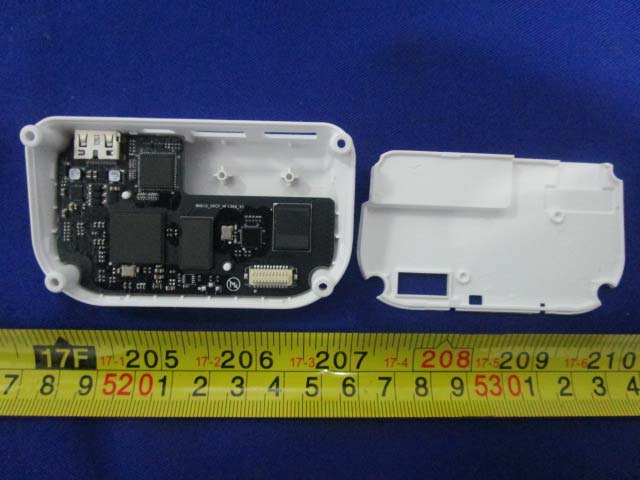
This PCB features a robust multi-layer design, carefully balancing analog and digital sections. Metal shields cover critical RF components to maintain signal purity and reduce interference. Connectors visible here support control sticks and external interfaces, highlighting the device’s modular nature. Power regulation is evident through multiple capacitors and inductors, essential for stable operation. Overall, the design demonstrates DJI’s commitment to reliability and precise drone control.
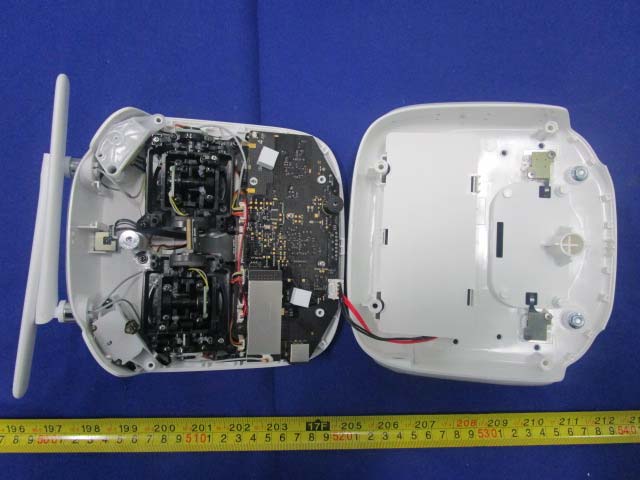
The PCB in this section exhibits clear RF communication capabilities with dual-frequency labeling (900 MHz and 5.8 GHz). Metal shielding protects sensitive RF components, while the board layout suggests careful impedance control and multi-layer routing. Connectors visible here likely interface with antennas or sensor modules, emphasizing the drone’s expandable design. Power regulation components underline the importance of stable and efficient power delivery, vital for reliable drone performance.
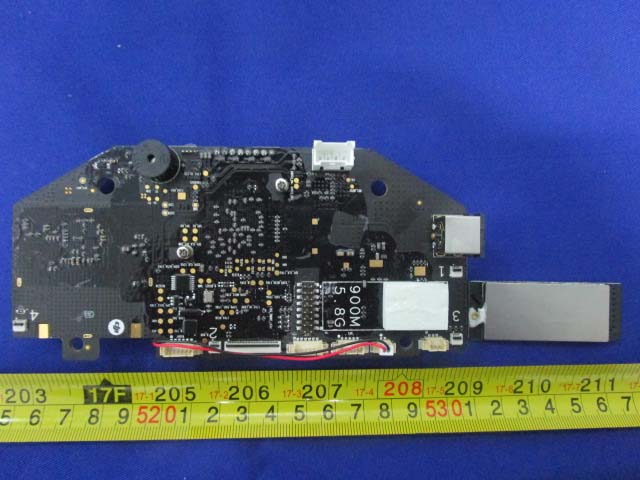
A simpler PCB design is observed here, primarily providing interface functions. The presence of a micro USB port and SD card slot suggests data transfer and storage capabilities. The absence of complex ICs or power components indicates a specialized role, likely as an expansion or interface module within the drone’s modular ecosystem.
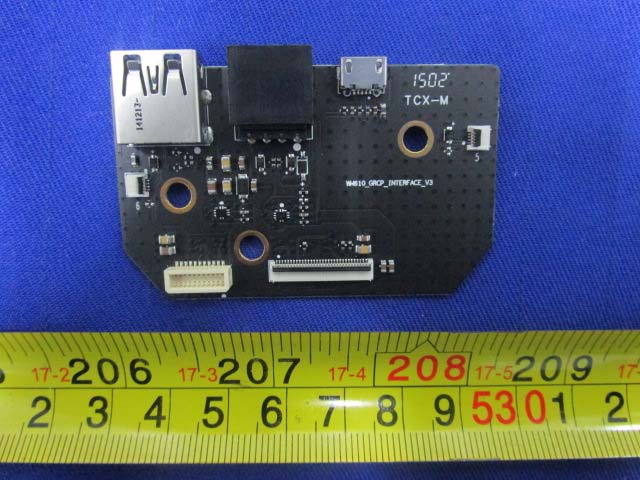
This densely populated PCB integrates processing capabilities, memory, and power management in a compact form factor. The presence of capacitors, inductors, and a crystal oscillator highlights careful attention to stable operation and timing precision. The USB connector and multi-pin interface suggest modular connectivity options, essential for integration with additional peripherals or sensors.
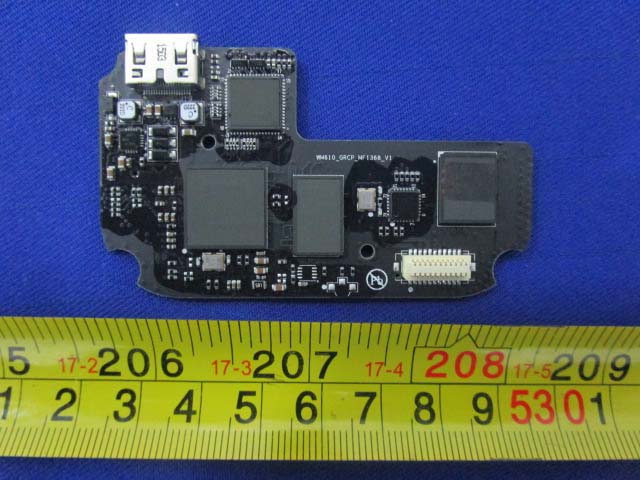
Regulatory Insights & FCC Filing
The DJI Matrix 100 holds FCC certification under ID SS3-GL658C1504, affirming its compliance with U.S. electromagnetic interference standards, allowing legal sale and operation. FCC filings typically include test reports for RF exposure, electromagnetic compatibility (EMC), internal and external photographs, user manuals, schematics, and block diagrams.
According to the user manual, the Matrix 100 is explicitly designed as an open platform for developers, offering modular hardware and access to DJI’s SDK API. The next-generation flight controller and DJI Lightbridge technology provide stable flight performance and real-time HD video downlink, respectively. The expandable center frame allows users to mount additional devices, enhancing functionality and versatility.
Potential Use Cases & Target Audience
Given its modular design and open SDK, the DJI Matrix 100 is ideal for:
- Industrial Inspection & Monitoring: Developers can integrate thermal imaging or LiDAR sensors for infrastructure inspection, agriculture monitoring, or environmental surveying.
- Academic Research & Development: Universities and research institutions can leverage the SDK and expandable hardware to test advanced flight algorithms, robotics integration, or autonomous navigation systems.
- Custom Commercial Solutions: Companies can rapidly prototype specialized drone solutions for industries like public safety, media production, or logistics, thanks to the flexible hardware design and comprehensive developer tools.
Conclusion
The DJI Matrix 100 (FCC ID: SS3-GL658C1504) stands out as a highly capable and versatile drone platform for professional developers and commercial operators. Its modular hardware, open SDK, advanced flight control system, and robust wireless communication capabilities provide a powerful foundation for specialized aerial applications. The FCC certification underscores DJI’s commitment to regulatory compliance and device reliability, positioning the Matrix 100 as a trustworthy choice for demanding drone solutions.